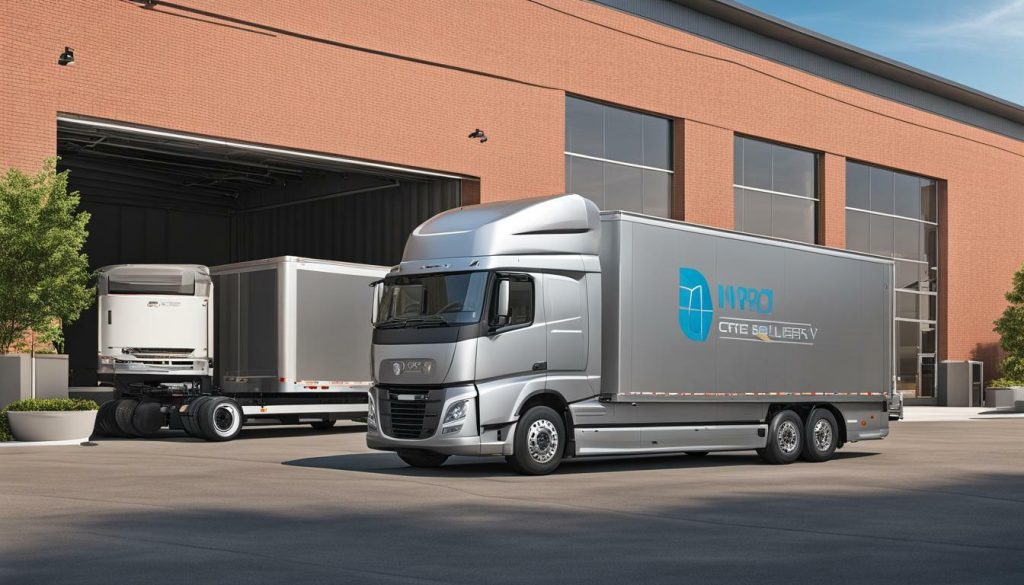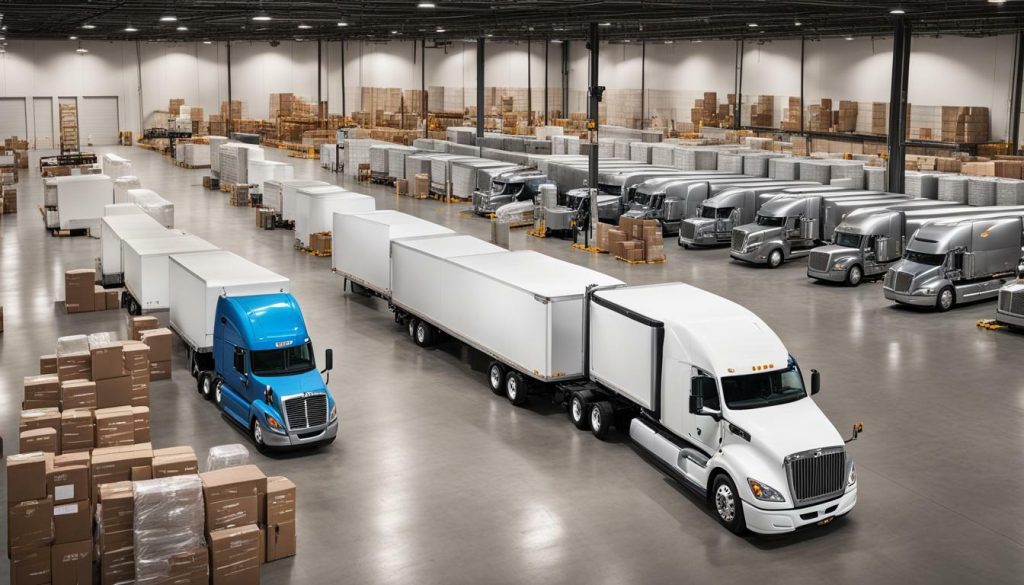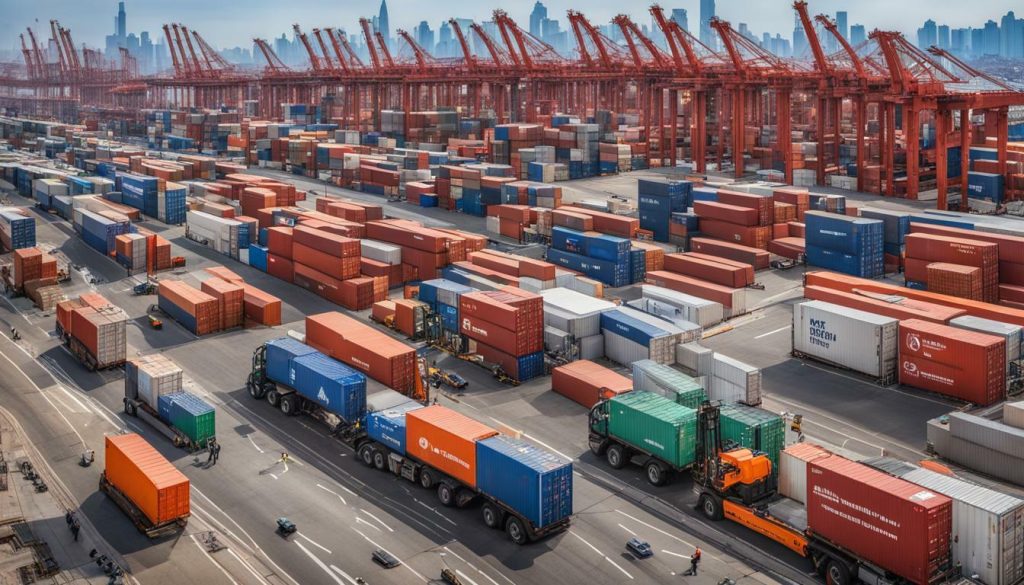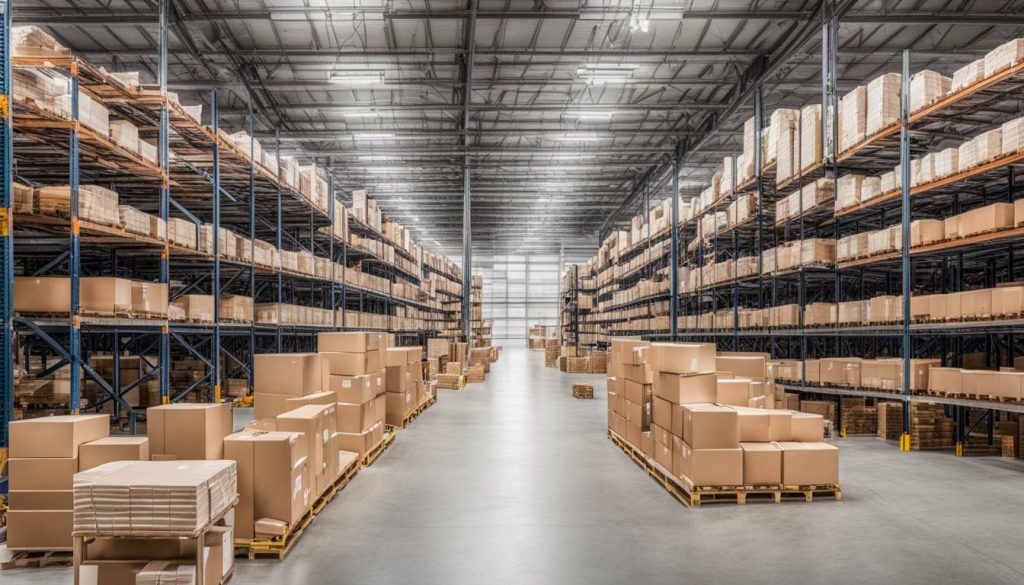As a local freight delivery service, improving your efficiency is crucial for providing reliable and cost-effective services to your customers. By optimizing your operations and implementing effective strategies, you can enhance your local freight delivery efficiency and boost your business performance.
In this section, we will discuss practical strategies for achieving efficient local freight delivery. From streamlining operations to utilizing technology, we will provide key insights into how you can optimize your freight delivery services for maximum efficiency.
Key Takeaways
- Efficient local freight delivery requires a combination of optimized operations and effective strategies.
- Streamlining your operations can enhance your freight delivery efficiency and reduce costs.
- Effective route planning, load consolidation, and vehicle utilization are critical for achieving optimal freight delivery performance.
Table of Contents
Streamlining Operations for Efficient Local Freight Delivery
To achieve optimized freight delivery, it’s essential to streamline your operations. This involves assessing and optimizing various aspects of your delivery process, such as route planning, load consolidation, and vehicle utilization. By implementing these strategies, you can enhance efficiency and improve overall performance.
Assess Your Delivery Process
Start by assessing your current delivery process to identify areas that need improvement. This may involve analyzing delivery times, vehicle utilization, and other key performance indicators (KPIs). Use this data to identify areas for improvement and develop a plan to streamline your operations.
Optimize Route Planning
Efficient route planning is a crucial aspect of streamlined freight delivery operations. Utilize advanced mapping and routing software to determine the most efficient routes, considering factors like traffic, distance, and delivery schedules. By optimizing your routes, you can reduce delivery times and minimize transportation costs.
Consolidate Loads
Load consolidation is another key strategy for improving local freight delivery efficiency. By combining multiple shipments into a single truckload, you can reduce transportation costs, minimize empty space and enhance overall efficiency. Consider implementing effective load consolidation strategies to optimize your freight delivery operations.
Utilize Technology to Streamline Operations
Embrace technology to enhance the reliability and efficiency of your local freight delivery service. Utilize real-time tracking systems to monitor shipments, provide accurate ETAs to customers, and address any potential delays promptly. Adopting automated inventory management systems can also streamline order processing and improve overall efficiency.

Effective Route Planning for Local Freight Delivery
If you want to provide fast local freight delivery, effective route planning is essential. Utilize advanced mapping and routing software to optimize your routes, reducing distance and time spent on the road. Consider factors like traffic patterns, delivery schedules, and road conditions to identify the most efficient delivery routes.
Collaborating with local freight carriers is another effective strategy for optimizing your routes. By working with experienced local freight carriers, you can take advantage of their knowledge of local roads and traffic patterns. They can help you identify the most efficient routes for your deliveries, reducing delivery time and costs.

By implementing effective route planning strategies, you can provide reliable freight delivery services while minimizing costs and improving customer satisfaction. Don’t overlook the importance of this key aspect of your delivery operations!
Load Consolidation Strategies for Optimal Freight Delivery
Consolidating loads can greatly improve local freight delivery efficiency. By combining multiple shipments into a single truckload, you can reduce transportation costs, minimize empty space, and enhance overall efficiency. Implement effective load consolidation strategies to optimize your freight delivery operations.
Start by analyzing your delivery patterns and identifying which shipments can be combined into a single load. Look for shipments that have similar delivery destinations or are going in the same direction.
Next, consider the type of goods being shipped. Group together shipments with similar or compatible products to prevent damage or contamination. Use appropriate packaging materials and secure the load properly to avoid any accidents or delays.
Utilize technology to aid in load consolidation. Advanced software can help you plan and optimize the most efficient route for consolidated shipments and track inventory levels accurately. This technology can also provide real-time updates on delivery status, helping you to manage your operations more effectively.
Collaborate with other businesses or freight carriers to find opportunities for consolidation. Partnering with businesses that have complementary delivery patterns can help you to increase the volume of consolidated shipments, thereby improving efficiency and saving costs.
| Benefits of Load Consolidation | |
|---|---|
| Reduced transportation costs | Minimized empty space |
| Enhanced efficiency | Reduced risk of damage or contamination |

Utilizing Technology for Efficient Local Freight Delivery
Delivering reliable freight services is a crucial aspect of maintaining a successful local freight delivery service. Utilizing technology can help you improve your delivery services and enhance efficiency. For instance, real-time tracking systems can keep you updated on your shipments’ whereabouts, enabling you to provide accurate ETAs to customers and address possible delays promptly. Automated inventory management systems also help streamline order processing, reducing errors and enhancing overall efficiency.
Further, technology can help you enhance collaboration with your suppliers and customers for an efficient local freight delivery service. Offering dedicated communication channels to your suppliers and customers can allow for effective communication and easy sharing of relevant information. This minimizes errors, reduces delays, and enhances the reliability of your freight delivery services.
Using technology in your local freight delivery service can also help you meet regulatory requirements. With technology, you can stay updated with regulations, obtain relevant permits and licenses, and implement robust safety protocols. This ensures that you comply with freight regulations, minimize disruptions in your delivery operations, and avoid penalties.

Utilizing technology in local freight delivery services is no longer an option but a requirement. It enables you to stay ahead of the competition, improve efficiency, and offer a reliable freight delivery service.
Enhancing Warehouse Operations for Efficient Freight Delivery
Optimizing your warehouse operations is crucial for achieving efficient local freight delivery. To begin, implement an efficient inventory management system to ensure accurate stock levels and minimize order processing time. Utilize efficient picking and packing processes to reduce errors and improve overall efficiency. Remember, every second counts when it comes to providing efficient local freight delivery.
Consider adopting technology like a warehouse management system to automate processes such as order routing and inventory tracking. This can help reduce human error and streamline operations for optimized freight delivery. Additionally, utilizing automated picking and packing systems can further enhance efficiency for faster and more reliable local freight delivery.
It’s important to regularly evaluate your warehouse operations to identify areas for improvement. Analyze key performance indicators such as order processing time and accuracy, inventory levels, and space utilization. This will help you make data-driven decisions for enhanced local freight delivery efficiency.

Remember, warehouse operations are a critical component of your overall local freight delivery service. Make sure your warehouse is optimized for efficient local freight delivery to provide your customers with reliable, on-time deliveries and cost-effective services.
Collaborating with Reliable Freight Carriers
To ensure reliable freight delivery, building strong partnerships with local freight carriers is crucial. Collaborate with carriers that have a proven track record of efficient and timely deliveries. Partnering with reliable local freight carriers can significantly improve the speed and accuracy of your local freight delivery service.
Regularly assess carrier performance to ensure consistent quality and efficiency. By working closely with your local freight carriers, you can identify areas for improvement and optimize your freight delivery operations. Efficient collaboration with reliable freight carriers is key to achieving a seamless local freight delivery service that meets and exceeds customer expectations.

Optimizing Vehicle Utilization for Cost-Effective Freight Delivery

To achieve cost-effective freight delivery, optimizing vehicle utilization is essential. Implementing efficient load planning strategies can maximize the payload capacity of each vehicle, reducing the number of trips required to transport goods. This can lead to significant cost savings and enhance overall efficiency.
Consider adopting technologies like telematics to monitor fuel consumption and driver behavior. This can help identify areas for improvement, such as reducing idle time or minimizing aggressive driving, which can contribute to fuel waste and higher costs.
Additionally, optimizing your vehicle fleet can also enhance cost-effectiveness. Assess the size and capacity of your vehicles to ensure they are suitable for your delivery needs. This can help avoid overcapacity or underutilized vehicles, leading to more efficient delivery operations.
Effective Communication and Collaboration within the Supply Chain
To achieve reliable and efficient local freight delivery, communication and collaboration within the supply chain are essential. Establishing strong relationships with suppliers, customers, and other stakeholders will help ensure effective communication and timely delivery of goods. Open channels of communication and share relevant information promptly to minimize delays and errors.
Regularly communicate with local freight carriers to ensure seamless coordination between your operations and theirs. Developing a mutually beneficial partnership with carriers that have a proven track record of reliability will help minimize delivery errors and delays.
Implementing efficient communication channels, such as real-time tracking systems and automated notifications, will enable proactive issue resolution and improve overall reliability. Utilize advanced technologies to foster collaboration and streamline communication, ensuring that everyone in the supply chain remains on the same page.

By prioritizing communication and collaboration, you can achieve efficient local freight delivery and build a solid foundation for the growth of your business.
Ensuring Compliance with Local Freight Regulations
To maintain an efficient local freight delivery service, it is crucial to ensure compliance with local freight regulations. Failure to comply with these regulations may lead to fines, penalties, and disruptions in your delivery operations. Therefore, it is essential to stay updated with relevant laws and regulations, obtain necessary permits and licenses, and implement robust safety protocols.
| Regulation | Compliance Requirements |
|---|---|
| Hours of Service (HOS) Regulations | Ensure that drivers comply with HOS regulations to avoid fatigue-related accidents. Keep accurate records of drivers’ working hours and take necessary measures to prevent violations. |
| Vehicle Maintenance and Inspection | Maintain your vehicles regularly and conduct thorough inspections to ensure that they meet safety standards. Keep accurate records of maintenance and inspection activities. |
| Weight and Size Restrictions | Adhere to weight and size restrictions set by local authorities to prevent damage to infrastructure and ensure road safety. |
| Dangerous Goods Transport | Comply with regulations related to the transportation of hazardous materials to prevent accidents and ensure the safety of people and the environment. |
Ensure that your employees are trained and informed about these regulations and that they take necessary measures to avoid violations. By following these compliance requirements, you can maintain a safe and efficient local freight delivery service.

By ensuring compliance with local freight regulations, you can provide a reliable and efficient local freight delivery service. Reliable compliance can also help you build trust and credibility with your customers and other stakeholders.
Regular Evaluation and Continuous Improvement of Freight Delivery Efficiency
To ensure the efficiency of your local freight delivery service, it is essential to regularly evaluate and analyze key performance indicators (KPIs) such as on-time delivery rates, cost per mile, and customer satisfaction. By tracking these metrics, you can identify areas for improvement and implement continuous improvement initiatives to enhance your freight delivery operations.
Start by setting clear goals and targets for your freight delivery operations. Use these targets as benchmarks for your performance and regularly review them to ensure you remain on track. Analyze your delivery routes and schedules, and consider making adjustments to optimize your freight delivery efficiency.
Regularly assess the performance of your freight carriers, utilizing metrics such as delivery times and freight damage rates to measure their reliability. Collaborate with carriers to identify areas for improvement and provide feedback to ensure consistent quality and efficiency.
Utilize technology to monitor your freight delivery operations in real-time. This can help you identify potential delays or issues promptly and take proactive steps to mitigate them. Additionally, consider utilizing automation technologies to streamline your order processing and inventory management, reducing errors and saving time.
Implementing continuous improvement initiatives is crucial for maintaining an efficient local freight delivery service. Continuously assess your operations and processes, looking for ways to optimize and streamline your performance. By making incremental improvements over time, you can significantly enhance your local freight delivery efficiency and provide a reliable and cost-effective service to your customers.

Conclusion
Improving your local freight delivery efficiency is vital for providing a reliable and cost-effective service. By streamlining your operations and utilizing technology, you can optimize your delivery process, reduce transportation costs, and enhance overall efficiency.
Collaborating with reliable freight carriers and optimizing vehicle utilization can further help achieve cost-effectiveness and improve service quality. It is also crucial to maintain compliance with local freight regulations and foster efficient communication and collaboration within the supply chain.
Regularly evaluating your freight delivery efficiency and continuously improving your processes is key to sustaining optimal performance. By implementing the strategies outlined in this article, you can enhance the efficiency of your local freight delivery operations and boost your business success.
FAQ on Local Freight Delivery Efficiency
Q: How can I improve the efficiency of my local freight delivery?
A: There are several strategies you can implement to enhance the efficiency of your local freight delivery operations. These include streamlining your operations, effective route planning, load consolidation, utilizing technology, enhancing warehouse operations, collaborating with reliable freight carriers, optimizing vehicle utilization, ensuring effective communication and collaboration within the supply chain, complying with local freight regulations, and regularly evaluating and continuously improving your freight delivery efficiency.
Q: How can I streamline my local freight delivery operations?
A: Streamlining your operations involves assessing and optimizing various aspects of your delivery process, such as route planning, load consolidation, and vehicle utilization. By identifying areas for improvement and implementing efficient strategies, you can achieve optimized local freight delivery.
Q: What is the importance of effective route planning for local freight delivery?
A: Effective route planning plays a significant role in ensuring fast and reliable local freight delivery. By utilizing advanced mapping and routing software, considering factors like traffic, distance, and delivery schedules, you can determine the most efficient routes. Collaborating with local freight carriers can also help identify the most optimal delivery routes.
Q: How can load consolidation improve local freight delivery efficiency?
A: Load consolidation involves combining multiple shipments into a single truckload. By doing so, you can reduce transportation costs, minimize empty space, and enhance overall efficiency. Implementing effective load consolidation strategies can optimize your local freight delivery operations.
Q: How can technology be utilized for efficient local freight delivery?
A: Embracing technology can enhance the reliability and efficiency of your local freight delivery service. By utilizing real-time tracking systems to monitor shipments, providing accurate ETAs to customers, and adopting automated inventory management systems, you can streamline order processing and improve overall efficiency.
Q: How can I enhance warehouse operations for efficient freight delivery?
A: Optimizing warehouse operations is essential for efficient freight delivery. By implementing efficient inventory management systems, utilizing efficient picking and packing processes, and ensuring accurate stock levels, you can minimize order processing time and reduce errors.
Q: How do I collaborate with reliable freight carriers?
A: Building strong partnerships with reliable freight carriers is crucial for efficient local freight delivery. Collaborate with carriers that have a track record of reliability and timely deliveries. Regularly assess carrier performance to ensure consistent quality and efficiency.
Q: How can I optimize vehicle utilization for cost-effective freight delivery?
A: Optimizing vehicle utilization is key to cost-effective freight delivery. Implement efficient load planning to maximize the payload capacity of each vehicle. Consider adopting technologies like telematics to monitor fuel consumption and driver behavior, allowing you to identify areas for improvement and reduce costs.
Q: How important is effective communication and collaboration within the supply chain for efficient local freight delivery?
A: Efficient communication and collaboration within the supply chain are vital for efficient local freight delivery. Foster strong relationships with suppliers, customers, and other stakeholders. Implement effective communication channels and share relevant information promptly to minimize delays and errors.
Q: What is the significance of ensuring compliance with local freight regulations?
A: To maintain an efficient local freight delivery service, it is crucial to ensure compliance with local freight regulations. Stay updated with relevant laws and regulations, obtain necessary permits and licenses, and implement robust safety protocols. Adhering to regulatory requirements will help avoid penalties and disruptions in your delivery operations.
Q: How can I regularly evaluate and continuously improve my freight delivery efficiency?
A: Regularly evaluate your freight delivery efficiency by analyzing key performance indicators (KPIs) such as on-time delivery rates, cost per mile, and customer satisfaction. Identify areas for improvement and implement continuous improvement initiatives to enhance your local freight delivery operations.


